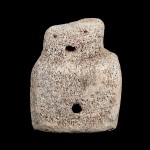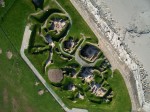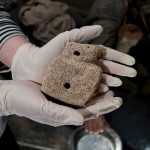I don’t know why stories sometimes form little geographical clusters, but it seems to happen fairly regularly. Last month it was Denmark and now it’s Scotland. Today’s Scottish report comes to us from the Stromness Museum which has rediscovered a highly significant Neolithic figurine that was undocumented and unrecognized its collection for almost a century.
 It’s an anthropomorphic figurine 9.5cm (3.7 inches) high and 7.5cm (3 inches) wide carved out of whale bone. Holes were carved to indicate eyes, a mouth and a navel. There are also holes carved through the sides of the head and body, possibly used to hang it as a pendant. The figurine was discovered in the Neolithic village of Skara Brae, Orkney, in the 1860s. Skara Brae is the most complete Neolithic village in Europe with eight dwellings clustered together. was found in the stone bed compartment of Skara Brae’s House 3, a structure that stratigraphically and from radiocarbon testing of the context to between 2900 and 2400 B.C., so the figurine is about 5,000 or 4,500 years old. It is one of only a handful of prehistoric representations of humans discovered in Britain. It was the first one found and the only one made of whale bone.
It’s an anthropomorphic figurine 9.5cm (3.7 inches) high and 7.5cm (3 inches) wide carved out of whale bone. Holes were carved to indicate eyes, a mouth and a navel. There are also holes carved through the sides of the head and body, possibly used to hang it as a pendant. The figurine was discovered in the Neolithic village of Skara Brae, Orkney, in the 1860s. Skara Brae is the most complete Neolithic village in Europe with eight dwellings clustered together. was found in the stone bed compartment of Skara Brae’s House 3, a structure that stratigraphically and from radiocarbon testing of the context to between 2900 and 2400 B.C., so the figurine is about 5,000 or 4,500 years old. It is one of only a handful of prehistoric representations of humans discovered in Britain. It was the first one found and the only one made of whale bone.
 The figurine was found by William Watt, Laird of Skaill House and owner of the property, who had discovered the site in 1850 when a storm exposed stone walls and a midden previously hidden under drift sand. Watt excavated the entire site with occasional visits from other amateur archaeologists James Farrer and George Petrie. The only existing documentation of the figurine is in Petrie’s 1867 report (pdf) in the Proceedings of the Society of Antiquaries of Scotland on the Skara Brae settlement and its artifacts. He described it as a “small piece of Whalebone, cut as if intended for an idol or ‘Fetish.'” Petrie also made a sketch of it in his notebook.
The figurine was found by William Watt, Laird of Skaill House and owner of the property, who had discovered the site in 1850 when a storm exposed stone walls and a midden previously hidden under drift sand. Watt excavated the entire site with occasional visits from other amateur archaeologists James Farrer and George Petrie. The only existing documentation of the figurine is in Petrie’s 1867 report (pdf) in the Proceedings of the Society of Antiquaries of Scotland on the Skara Brae settlement and its artifacts. He described it as a “small piece of Whalebone, cut as if intended for an idol or ‘Fetish.'” Petrie also made a sketch of it in his notebook.
 The historical significance of the piece wasn’t recognized at the time. The artifact was assumed to be in the private museum Watt created at Skaill House, but there was no record of it. When the collection was broken up in the 1930s and distributed to various museums including the Stromness Museum, the figurine appeared in none of the inventories. It was believed lost forever.
The historical significance of the piece wasn’t recognized at the time. The artifact was assumed to be in the private museum Watt created at Skaill House, but there was no record of it. When the collection was broken up in the 1930s and distributed to various museums including the Stromness Museum, the figurine appeared in none of the inventories. It was believed lost forever.
The figurine was rediscovered by Dr. David Clarke who was going through Stromness Museum’s Skaill House artifacts as part of a research project on Skara Brae. None of the Skaill pieces included a provenance, so Dr. Clarke had to look through the entire collection for anything that might have come from Skara Brae.  When he saw that little face peering out of a bed of tissue in the last box of the day, he immediately recognized it from Petrie’s illustration.
When he saw that little face peering out of a bed of tissue in the last box of the day, he immediately recognized it from Petrie’s illustration.
Additional research by Clarke and museum experts confirmed the identification and its original find spot. The figurine has been given a new name, Skara Brae Buddo (“buddo” is the Orcadian word for “friend”), and is now on display in the Stromness Museum’s new Rediscovered exhibition along with other artifacts from Skara Brae that have never been on display before.
You can explore Skara Brae Buddo’s amiable mien in this 3D model created by Dr. Hugo Anderson-Whymark.
Skara Brae 'Buddo' Figurine, Orkney
by Stromness Museum
on Sketchfab